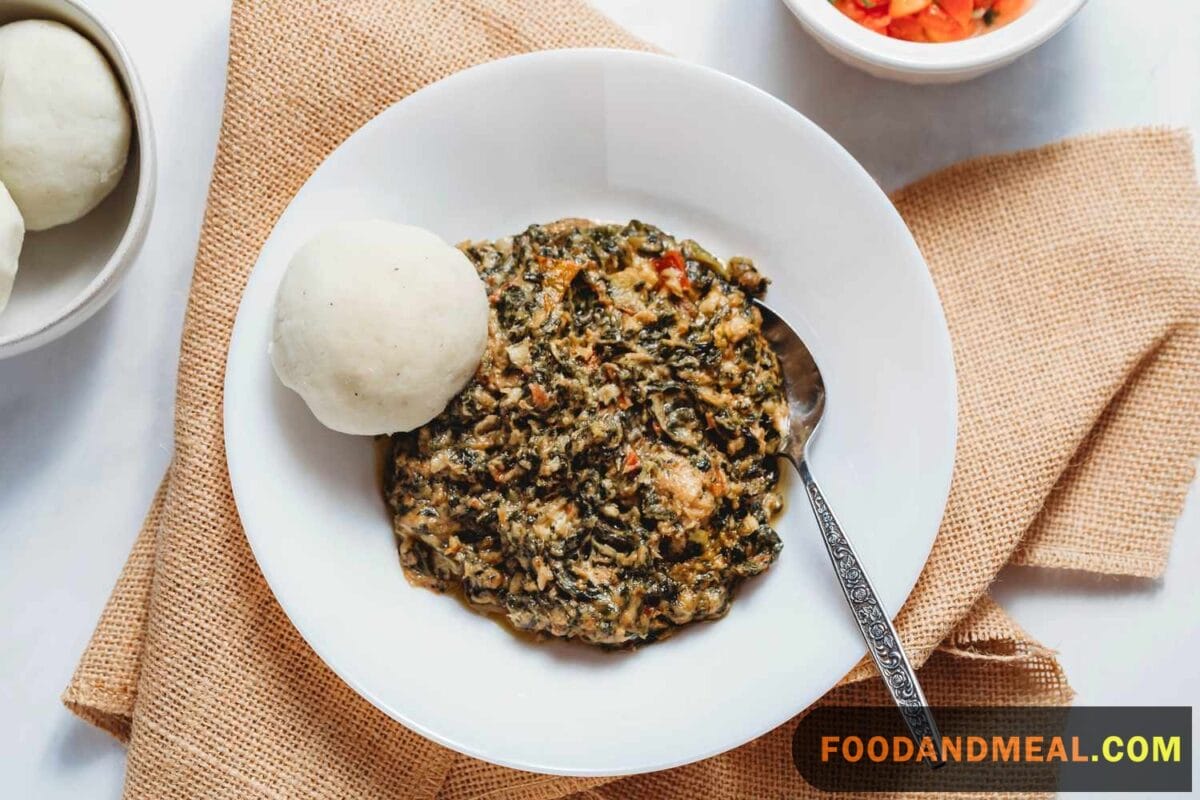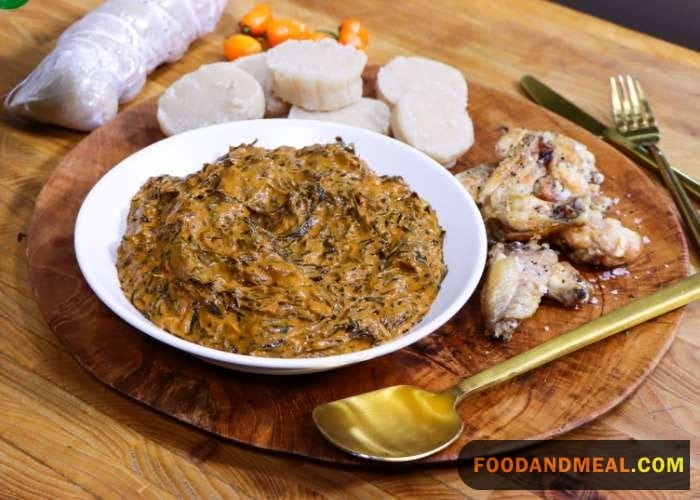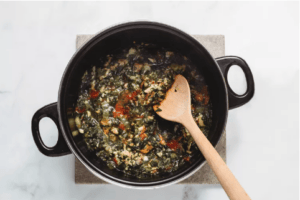Fumbwa, also known as wild spinach stew, is a culinary gem from the Democratic Republic of Congo. It’s a dish that has always fascinated me with its unique blend of flavors and textures. The way the spinach melds with the rich, nutty undertones of peanut butter and the distinct flavor of palm oil creates a symphony of taste that is both comforting and exotic.
My interest in Fumbwa was sparked during my culinary explorations. I’ve always been drawn to dishes that tell a story, that carry the essence of their place of origin, and Fumbwa does just that. It’s not just a stew; it’s a testament to the resourcefulness and creativity of Congolese cooking.
The process of making Fumbwa is an art in itself. The spinach is simmered until tender, then combined with a paste of ground peanuts, tomatoes, onions, and dried fish. The result is a creamy, flavorful stew that is both nutritious and satisfying.
But why Fumbwa, you might ask? Well, as a chef, I believe in pushing boundaries and exploring new flavors. And as someone who raises his own pigs for the succulent offerings at my barbecue truck, I appreciate the value of using fresh, local ingredients. Fumbwa embodies these principles, making it a dish that resonates with me on a personal level.
In my journey with Food And Meal, I’ve had the privilege of sharing my passion for food with a wider audience. And now, I want to share with you the magic of Fumbwa. I hope this dish will inspire you as much as it has inspired me, and perhaps even encourage you to embark on your own culinary adventures.
Fumbwa Recipe
Fumbwa, a traditional delight, brings forth the vibrant flavors and rich heritage of the continent. As a seasoned chef, I’m thrilled to share this treasured recipe with you. Get ready to embrace the greens, savor the flavors, and create a dish that’s not just food but a story on a plate.


Fumbwa (Wild Spinach in Palm Oil and Peanuts) Recipe
Equipment
Ingredients
- 2 kilos fumbwa (you can substitute with any other green veggie such as collards kale, cassava leaves, turnip greens, or spinach.
- ½ cup peanut butter or 1 cup peanuts
- 2 to tomatoes
- 1 medium onion
- 2 tablespoons red palm oil
- 4 ounces dried or smoked fish
- Water
Instructions
- Clean the veggie, remove hard stems, and shred finely.
- If using peanut seeds, ground them into a fine paste.
- Chop/crush the tomatoes and dice the onions.

- Debone the smoked fish and soak in water for a few minutes, and rinse.

- Parboil the fumbwa in an uncovered pot with a lot of water until it becomes tender.

- Place a pan over medium heat, put the parboiled veggies to it, and add 1 cup of the parboiled water.

- Add the sliced onions, tomatoes, and smoked fish to the pot and mix well.
- In a bowl, mix the peanut butter or ground peanut paste with 1 cup of the parboiled water and make a smooth

- Stir in the mixture to the veggies and add the red palm oil. Stir thoroughly, cover, and cook on medium heat for 7 minutes.

- Enjoy with baton de manioc, fufu, yam, rice, or sweet potatoes.

Notes
- This dish is traditionally served with fou (fufu) or boiled plantains.
- Take care with the addition of salt or stock, especially if the smoked fish is salty.
Nutrition
© Food And Meal
This website provides approximate nutrition information for convenience and as a courtesy only. Nutrition data is gathered primarily from the Spoonacular Database, whenever available, or otherwise other online calculators.
Fumbwa recipe congolese

In the pressure cooker, heat palm oil and sauté onions, garlic, red bell pepper, and green chili until onions are translucent. Stir in groundnut paste, then add cassava leaves, spinach, and kale. Pour in broth, add spices, and pressure-cook for 10-15 mins. Release pressure, season with salt and pepper, and adjust spice levels if desired. Serve hot with rice, fufu, or chapati.
Fumbwa congolese spinach stew recipe
The star of the show is, of course, the fumbwa leaves, also known as wild spinach. These leaves are packed with nutrients and have a unique, slightly bitter flavor that adds depth to the stew. The process of preparing the leaves, which involves washing, chopping, and sometimes even pounding them, is a labor of love that connects you to the food you’re about to cook.
The other ingredients in the stew – palm oil, onions, garlic, chili peppers, and often some type of meat or fish – each play their part in creating a symphony of flavors. The palm oil gives the stew its characteristic rich, velvety texture, while the onions and garlic add a savory depth. The chili peppers provide a kick of heat that can be adjusted to taste, and the meat or fish contributes a hearty, satisfying element to the dish.
Cooking Fumbwa is an exercise in patience and mindfulness. The stew needs to simmer slowly on the stove, allowing the flavors to meld together and the fumbwa leaves to become tender. This slow cooking process fills the kitchen with a mouthwatering aroma that builds anticipation for the meal to come.
When the Fumbwa is finally ready, it’s a moment of pure joy. The stew is thick and hearty, with a complex flavor profile that is at once earthy, spicy, and slightly bitter. It’s the kind of dish that warms you from the inside out, nourishing both body and soul.
Tips for making Fumbwa

Cooking tips
The process of cooking Fumbwa is an art in itself. It begins with placing the greens in a large pot, followed by grinding peanuts into a fine paste. As the greens become tender and the liquid reduces, tomatoes, leek or onion, and dried fish are added to the mix. A cup of the pot liquid is then combined with the peanut paste, creating a creamy texture that is characteristic of this dish.
However, the magic of cooking Fumbwa goes beyond the ingredients and the technique. It lies in the emotions that are stirred along with the stew. Cooking, after all, is a form of self-expression and creativity. It’s a way to convey love, care, and even happiness. When you cook Fumbwa in a cheerful mood, the resulting dish is not just delicious but also carries a healing power. It’s as if the positive energy gets transferred from the cook to the stew, making it more than just a meal, but an experience.
That being said, it’s important to remember that while expressing our emotions through cooking, we should avoid using strong or forceful language. The beauty of cooking lies in its subtlety and gentleness. Just like the delicate balance of flavors in Fumbwa, our words should be measured and thoughtful. After all, the goal is to create a dish that brings joy and satisfaction, not discomfort or unease.
In terms of nutrition, Fumbwa is a powerhouse. Each serving contains 422 calories, 33g of fat, 14g of carbs, and 22g of protein. But more than the numbers, it’s the feeling of satiety and contentment that makes Fumbwa a truly satisfying meal.
Serving Suggestions

For a traditional pairing, consider serving Fumbwa with Jollof Rice or Bunny Chow. These dishes are both filling and flavorful, making them the perfect accompaniment to the rich and hearty Fumbwa.
If you’re looking for something lighter, a side of Sautéed Baby Bok Choy or Roasted Cabbage Wedges could complement the Fumbwa nicely. The crispness of these vegetables would provide a nice contrast to the creaminess of the stew.
For those who enjoy a bit of heat, pairing the Fumbwa with Spicy Cod Stew or Kimchi Hot Dogs could be an interesting choice. On the other hand, if you prefer a milder flavor profile, the dish could be served alongside Soft Tofu Stew or Rice Cake Soup.
When it comes to drinks, a refreshing Cucumber Water or Witch’s Brew could balance out the richness of the Fumbwa. And for dessert, why not try some Sweet Mochi or Apple Crumble?
5 FAQs about Fumbwa

- What are the best greens for Fumbwa? Cassava leaves are traditional, but you can use spinach or collard greens as substitutes. Ensure they are finely chopped
- Can I use vegetable oil instead of palm oil? Yes, vegetable oil is a suitable alternative, but palm oil provides a more authentic flavor.
- How do I reduce the bitterness in the greens? Add a pinch of baking soda while cooking the greens to counteract bitterness.
- Can I make Fumbwa in advance? Yes, Fumbwa tastes even better the next day. Refrigerate any leftovers in an airtight container.
- Is Fumbwa traditionally spicy? Fumbwa has a mildly spicy flavor due to ginger, garlic, and bouillon cubes. You can adjust the spice level to your preference.
Conclusion
In conclusion, the Fumbwa recipe is a culinary gem from the heart of Congo. This traditional stew, with its unique blend of wild spinach, peanuts, and red palm oil, offers a delightful exploration of African flavors. The process of making Fumbwa is a labor of love that rewards you with a rich, hearty dish that is both comforting and nutritious.
The detailed recipe provided by Food And Meal makes it easy for anyone to try their hand at this traditional Congolese dish. Whether you’re an experienced cook or a novice in the kitchen, this recipe guides you through each step, ensuring that you can successfully create this flavorful stew.
Moreover, the versatility of Fumbwa allows it to be served in various ways, catering to different tastes and preferences. It can be enjoyed as a standalone dish, served over steamed rice, or spooned into warm chapati. The choice of garnishes and accompaniments further enhances the dining experience, allowing you to customize the dish to your liking.
Overall, the Fumbwa recipe is more than just a set of cooking instructions. It’s a gateway to experiencing a part of Congo’s rich culinary heritage. So, whether you’re looking to try something new or simply want to enjoy a hearty, flavorful meal, the Fumbwa recipe from Food And Meal is definitely worth a try.
I'm Kelly Atkinson, with a passion for dissecting the world of home goods. My reviews stem from thorough testing and a love for sharing detailed insights. Each piece I write offers a glimpse into my explorative journey, aiming to guide readers to informed choices with authenticity and precision, making every review a blend of exploration and expertise.








